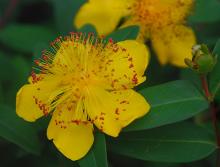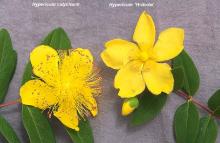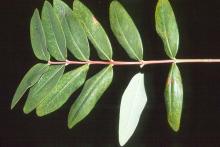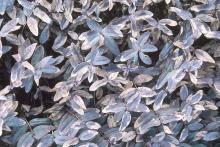Hypericum calycinum
Common name:
Creeping St. John's Wort
Aaron's Beard
Pronunciation:
hi-PER-i-kum kal-e-SI-num
Family:
Hypericaceae
Genus:
Type:
Broadleaf
Native to (or naturalized in) Oregon:
No
- Semi-evergreen, stoloniferous, ground cover, with procumbent or ascending stems, 12-18 inches (30-45 cm) high. Leaves opposite, simple, ovate-oblong, 5-10 cm long. Flowers yellow, 7.5 cm wide, blooms in early summer, occasionally throughout the summer.
- Sun to shade, some drought tolerance, invasive, "tough", often seen around parking lots and commercial buildings. In the Northwest it may suffer from Hypericum rust.
- Hardy to USDA Zone 6 Native to southeastern Europe and Asia Minor. This is not the Hypericum species considered by some to have therapeutic properties, that is the herb, Hypericum perforatum, also know as St. John's Wort or Klamath Weed. When an animal eats Hypericum perforatum, the poisonous compound in the plant, hypericin, reaches the skin from an internal route (stomach to blood to skin). Here it sensitizes the skin to sunlight and causes lesions; only white or unpigmented areas are affected.
- Caution: Hypericum calycinum can rather aggressive in a landscape and is considered invasive in some areas (e.g., parts of Washington and California). It spreads both by underground creeping rhizomes, above-ground stems, and by seeds that are dispersed by wind and animals.
-
Hypericum: Greek, hyper, above, and eikon, a picture, it was hung above pictures to ward off evil spirits. calycinum: with a conspicuous calyx.









